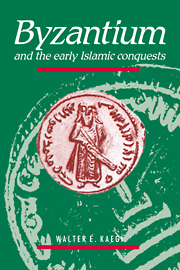Book contents
- Front Matter
- CONTENTS
- List of illustrations
- Preface
- List of abbreviations
- Chapter 1 The problem of Byzantium and the early Islamic conquests
- Chapter 2 The Byzantine Empire in an era of accelerating change
- Chapter 3 Difficulties in devising defenses for Syria
- Chapter 4 The first Muslim penetrations of Byzantine territory
- Chapter 5 Early tests in southern Palestine
- Chapter 6 Problems of cohesion: the battle of Jābiya- Yarmūk reconsidered
- Chapter 7 The brief struggle to save northern Syria and Byzantine Mesopotamia
- Chapter 8 Byzantium, Armenia, Armenians, and early Islamic conquests
- Chapter 9 Controversy and confidence in the seventh-century crisis
- Appendix 1 Author and date of the anti-jewish treatise
- Chapter 10 Elements of failure and endurance
- Bibliography
- Index
Chapter 7 - The brief struggle to save northern Syria and Byzantine Mesopotamia
Published online by Cambridge University Press: 22 September 2009
- Front Matter
- CONTENTS
- List of illustrations
- Preface
- List of abbreviations
- Chapter 1 The problem of Byzantium and the early Islamic conquests
- Chapter 2 The Byzantine Empire in an era of accelerating change
- Chapter 3 Difficulties in devising defenses for Syria
- Chapter 4 The first Muslim penetrations of Byzantine territory
- Chapter 5 Early tests in southern Palestine
- Chapter 6 Problems of cohesion: the battle of Jābiya- Yarmūk reconsidered
- Chapter 7 The brief struggle to save northern Syria and Byzantine Mesopotamia
- Chapter 8 Byzantium, Armenia, Armenians, and early Islamic conquests
- Chapter 9 Controversy and confidence in the seventh-century crisis
- Appendix 1 Author and date of the anti-jewish treatise
- Chapter 10 Elements of failure and endurance
- Bibliography
- Index
Summary
THE BYZANTINE ROUT AND DILEMMAS OF DEFENSE IN NORTHERN SYRIA AND MESOPOTAMIA
Byzantine flight after Jābiya-Yarmūk was understandable. As Clausewitz observed:
When a battle is lost, the strength of the army is broken — its moral even more than its physical strength. A second battle without the help of new and favorable factors would mean outright defeat, perhaps even absolute destruction. That is a military axiom. It is in the nature of things that a retreat should be continued until the balance of power is reestablished — whether by means of reinforcements or the cover of strong fortresses or major natural obstacles or the overextension of the enemy. The magnitude of the losses, the extent of the defeat, and, what is even more important, the nature of the enemy, will determine how soon the moment of equilibrium will return.
Among the many problems of historical explanation of the Muslim conquest of Byzantine territories in the seventh century is one that has been neglected: that is the role of Byzantine forces in northern Syria and Byzantine Mesopotamia after the battle of Jābiya-Yarmūk. Mesopotamia here refers to areas now in northern Syria east of the Euphrates or in Turkey east of the Euphrates and, of course, west of the Tigris, in Arabic the Jazīra. It comprised the provinces of Osrhoene and Mesopotamia in sixth- and seventh-century Byzantine nomenclature, and such cities as Callinicum (Raqqa), Edessa (Urfa, al-Ruhā'), Monokarton, Amida (Diyarbekir), Dara, and Mardes (Mardin), as well as the Ṭūr 'Abdīn region (Map 3).
- Type
- Chapter
- Information
- Byzantium and the Early Islamic Conquests , pp. 147 - 180Publisher: Cambridge University PressPrint publication year: 1992



